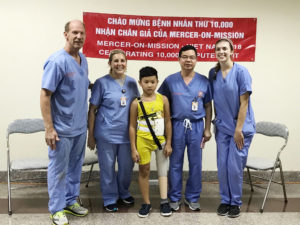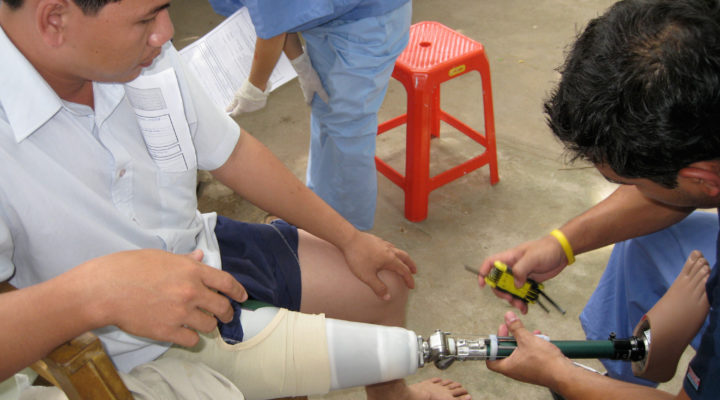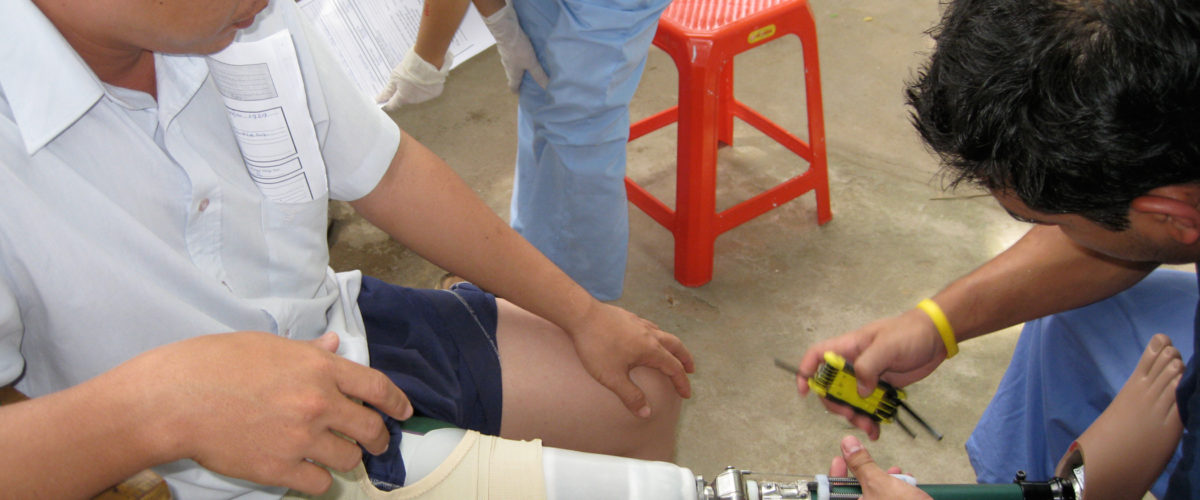Mercer on Mission fitted its 10,000th prosthetic leg this summer in Vietnam, and program leaders were naturally elated.
A press release was issued. Photos were taken.

Mercer on Mission team members pose with the 10,000th person to be fitted with a prosthetic leg in Vietnam. (Photo/Mercer University)
But those officials, after acknowledging the June 26 milestone, quickly expanded the subject to focus on the many whose lives have been transformed by the Mercer University initiative launched in 2009.
“People tell us ‘you changed us. You freed us. You healed us on the inside,” said Ha Van Vo, professor of biomedical engineering at the Macon, Georgia, university and leader of its annual Vietnam service.
Mercer on Mission is a study-abroad program that blends academic and hand-on experience addressing challenges around issues such as health, engineering, education, the environment, social justice and economic sustainability.
It began in 2007 with 38 students and six faculty working in three nations. Today, 260 students and some 45 faculty participate in programs in 14 countries, said Craig McMahan, director of Mercer on Mission.
The focus on engineering and prosthetics in Vietnam has made such an impact that the nation’s prime minister once asked that it be expanded, McMahan said.
“When you lose a limb, it’s a huge loss,” he said. “Through a prosthesis, you regain that function. It’s a big life changer for the people we see.”
Making that kind of difference has been a life-long dream for Vo, who grew up in Vietnam where an estimated 100,000 citizens lost limbs either during the war with the U.S., or after due to unexploded mines and other ordinance, he said.

Ha Van Vo
Amputees have an especially difficult time in Vietnam because its economy is based so much on manual labor, he said.
“I have always said ‘I wish I could return and help.’”
Mercer on Mission has helped him accomplish that goal. He now leads the teams of university students and faculty who operate four locations that fit patients with artificial limbs that he designed and patented and are praised for their durability and simplicity.
“When a person walks again they say ‘you brought my life back,’” Vo said. “That means so much to me.”
The impact of Vo’s work and the Mercer on Mission program expand far beyond the Vietnamese who are restored to walking and working, said Chris Sheridan, a Macon businessman who contributes $250,000 a year to the program through a family foundation.
“It absolutely helps the individual that gets the prosthesis, but it also helps their caretaker or whoever they are caring for,” said Sheridan. “So many of them are farmers who are trying to take care of their families.”
Nor do the blessings don’t stop there, he said. Sheridan said he’s been on several trips to Vietnam himself to fit patients and to help streamline the work process. It never fails that Mercer students and faculty are overwhelmed with emotion when they help people walk again.
And Sheridan said he has been transformed by his work with the program, which includes fabricating parts and other tools used by the Mercer on Mission teams.

A Vietnamese amputee gets accustomed to his new artificial leg. (Photo/Mercer University)
“It helps me live a life of gratitude every day,” he said.
But celebrating the milestone reached this summer can also have a big impact, namely to draw the attention of donors needed to keep the program growing.
“That 10,000 number is symbolic, but maybe it will inspire someone to come along side and partner with us,” Sheridan said.
The Vietnam operation has been growing since the beginning, McMahan said. Mercer on Mission in Vietnam fitted its first 5,000 artificial legs from 2009 to 2016, and the second 5,000 in the two years after that.
Progress and capacity are being tracked and improved, and the fitting process is constantly being streamlined, McMahan said. Prosthetic arms were introduced in the past year.
“The only thing holding us back now is funding,” he said. “We are trying to demonstrate to donors that we have a great product and, given more funding, we could make an even greater impact.”
Sometimes, McMahan added, donors aren’t the only ones who need convincing.
During a recent trip to Vietnam, McMahan said he was fitting a teen who had lost both his arms midway between the elbows and wrists.

Craig McMahan
But the boy seemed embarrassed and a bit skeptical throughout the process. Being told his new arms included hands that opened and closed with shoulder movements didn’t move him, he said.
“He had been a little distant,” McMahan recalled.
Finally, the boy was handled a bottle of water and instructed to unscrew the cap and take a drink. This, he said, was one of those moments that make the whole program worthwhile.
“As he held it to his lips this huge smile came across his face. All of a sudden, his world was different.”


